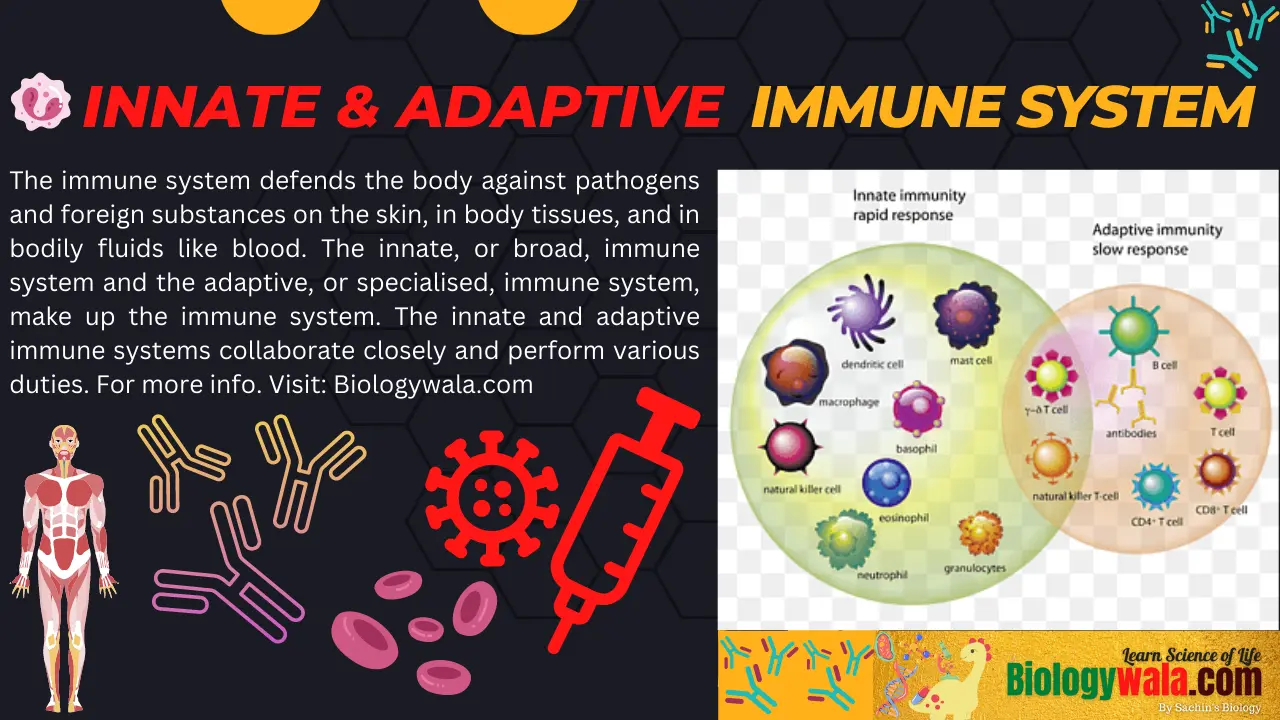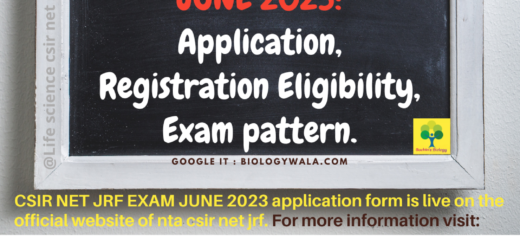The innate and adaptive immune system

The innate and adaptive immune systems:
The immune system defends the body against pathogens and foreign substances on the skin, in body tissues, and in bodily fluids like blood. The innate, or broad, immune system and the adaptive, or specialised, immune system, make up the immune system. The innate and adaptive immune systems collaborate closely and perform various duties.
The innate immune system: Efficient and quick
The body’s initial line of defence against pathogens entering the body is the innate immune system. It is also referred to as the “nonspecific” immune system since it reacts uniformly to all pathogens and foreign chemicals. It responds very fast, for example, ensuring that germs that have entered the skin through a minor wound are found and eliminated immediately within a few hours of their entry. However, the innate immune system has little ability to prevent the spread of infection.
- The epidermis, mucous membranes, immune system cells (defence cells), and proteins all provide protection as part of the innate immune system.
Skin and mucous membranes provide protection
The innate immune system plays a crucial role in protecting both the inside and outside of the human body. A physical barrier that prevents germs from entering is already formed by the closed surface of the skin and all mucous membranes. In addition, chemicals like acid, enzymes, and mucus stop bacteria and viruses from taking hold. Germs are prevented from settling in the body by movements made, for instance, by hair-like structures in the bronchi (cilia) or bowel muscles. Similar effects are produced by tear fluid, sweat, and urine (which clears the urinary tract’s organs).
Immune system cells (defence cells) and proteins provide protection.
If germs manage to pass through the skin and mucous membranes and enter the body, the innate immune system activates specialised immune system cells and proteins.
What transpires when inflammation occurs?
Immune system cells either migrate to an affected area of the skin or become active immune system cells that are already present. Certain immune system cells emit chemicals into the vicinity, causing the blood vessels to widen and become more permeable. Inflammation happens as a result of the swelling, heating up, and reddening of the area around the infection. Furthermore, a fever might appear. The blood vessels then dilate even more, and more immune cells start to accumulate. Certain proteins (enzymes) are also activated to help in the immune response (see below).
Scavenger cells: eradicating pathogens
Scavenger cells can immediately halt bacteria or viruses from entering the body (phagocytes). Specialized white blood cells are known as scavenger cells (leukocytes). Germs are contained and “digested” by these cells. These bacteria’ remnants migrate to the scavenger cells’ surface where the adaptive immune system can recognise them.
Other immune system cell types can also secrete chemicals that kill bacteria and other forms of pathogens. During an immunological response, pathogens, bodily tissue, and immune system cells all perish and degrade. They leave behind pus, a fluid with a yellow tint.
Function of proteins
A number of proteins (enzymes) support the innate immune system cells. Nine distinct enzymes work in a chain reaction-like manner to activate one another: One enzyme in the first step alerts a number of enzymes in the second stage, and each of those enzymes then activates a number of enzymes in the third stage, and so on. Due to this, immune system reactions might swiftly intensify.
These enzymes work by attracting other immune system cells from the bloodstream, identifying germs as targets for scavenger cells, killing bacteria by rupturing their cell walls, and fighting viruses by destroying the viral envelope (a virus’ outer layer) or virus-infected cells.
Natural killer cells are capable of looking for altered bodily cells
The third significant component of the innate immune system is the natural killer cells. They specialise in the detection of tumour-forming or virus-infected cells. To accomplish this, they look for cells whose surfaces have changed and then use cell toxins to demolish the cell surface.
The adaptive immune system: Directly combating pathogens
If the innate immune system is unable to eliminate the germs, the adaptive immune system takes over. It targets the specific kind of bacteria that is causing the infection. However, it must first recognise the germ in order to do that. This indicates that while it takes longer to react than the innate immune system, it is more precise when it does. Additionally, it has the benefit of “remembering” germs so that the adaptive immune system can react more quickly the next time a known germ is met.
Because your body develops “immune” subsequently, some illnesses are only contagious once in a lifetime because of this memory. The adaptive immune system may take a few days to react the first time it encounters the pathogen, but the next time, the body can respond right away. Usually, the second infection is so mild that it is not even felt.
The adaptive immune system comprises:
- T lymphocytes, which are found in the tissue between body cells, make up the adaptive immune system.
- B lymphocytes, which are likewise present in the tissue between body cells
- Antibodies in body fluids like blood
T lymphocytes
T lymphocytes, also known as T cells, are created in the bone marrow and then travel through the bloodstream to the thymus, where they mature. Their name “T” is derived from the word “thymus.”
Three key tasks of T cells include:
They start the adaptive immune system (T helper cells) by activating other immune system cells using chemical messengers, and they find and eliminate cancerous or virus-infected cells (cytotoxic T cells).
• After the virus has been eradicated, some T helper cells develop into memory T cells. When a new illness arises, they can quickly activate the adaptive immune system because they can “remember” which germs were eliminated.
T cells include detecting features that can connect to pathogens on their surfaces, similar to a lock that only a specific key will fit. Within a few days, the immune system may develop a specific type of T cell for each infection-causing microbe.
After that, if a germ attaches to a T cell that recognises it, the T cell begins to divide, producing additional T cells that are specialised to that germ. The immune response is tailored because only cells that match the germ multiply.
B lymphocytes
Bone marrow produces B lymphocytes (B cells), which mature there to become specific immune system cells. Their name comes from the letter “B” in “bone marrow.” Similar to T cells, several types of B cells are available that are matched to specific pathogens.
The T helper cells interact with B cells that are compatible with the same pathogens as them, activating the B cells as a result. The B cells become stimulated as a result, multiply, and change into plasma cells. These plasma cells manufacture enormous quantities of antibodies and release them into the bloodstream fast. Only the precise antibodies that are required will be created since only the B cells that match the invading microbes are activated. The numerous adaptive immune cells can communicate with one another directly or by soluble chemical messengers like cytokines (small proteins). These chemical messengers, which are primarily proteins, are created by various bodily cells.
Antibodies
Protein and sugar mixtures called antibodies go through the bloodstream. They are produced by the immune system in an effort to combat pathogens and foreign objects. Antibodies can adhere to potentially dangerous substances and identify pathogens swiftly. This destroys the “intruders” and entices additional immune system cells to lend a hand. The B lymphocytes create antibodies. “Antigens” also refers to germs and other things that can cause the production of antibodies.
An antigen can only bind to an antibody if it perfectly matches, acting as a key in the lock of the antibody. That is how antibodies find compatible pathogens to prompt the adaptive immune system’s quick response.
Antibodies have three primary purposes:
• They neutralise pathogens, such as viruses or bacteria, either directly binding to their cell surfaces or by latching to their toxins.
• They stimulate other immune system cells by adhering to their surfaces, preventing the germs from adhering to and infecting the body’s ordinary cells. Scavenger cells activate proteins that aid in the immune system response and are also better suited to combat bacteria that are covered in antibodies.
The innate immune system is assisted by the adaptive immune system’s antibodies.
comment below if you like the blog and if The innate and adaptive immune system blog helped you, it means a lot and will give us the energy to work with the same enthusiasm in future! This is it for today. See you in the Next article, Thank you!
You will also like :
Download the Free Book of Plant Physiology by Taiz and Zieger 6th edition
[Download] Plant Systematics by Gurcharan Singh PDF Book 3rd edition
If you want important notes and updates about exams on your mobile then you can join SACHIN’SBIOLOGY on Instagram or Facebook and can directly talk to the founder of Sachin’s Biology and Author of biologywala.com Mr Sachin Chavan M.Sc. NET JRF (AIR 21) GATE, MH-SET

![[DOWNLOAD] Research Methodology PDF Ranjit Kumar 5th edition 3 [DOWNLOAD] Research Methodology PDF Ranjit Kumar](https://biologywala.com/wp-content/uploads/2022/01/DOWNLOAD-Research-Methodology-PDF-Ranjit-Kumar-520x245.jpg)

I found your weblog web site on google and check just a few of your early posts. Proceed to maintain up the very good operate. I simply additional up your RSS feed to my MSN News Reader. Seeking forward to reading more from you later on!?
Oh my goodness! an incredible article dude. Thanks Nevertheless I am experiencing problem with ur rss . Don抰 know why Unable to subscribe to it. Is there anybody getting an identical rss drawback? Anybody who knows kindly respond. Thnkx
Your place is valueble for me. Thanks!?
Hiya! I simply wish to give an enormous thumbs up for the great information you may have here on this post. I will probably be coming again to your blog for more soon.
I received the package. Thank you for your prompt service. maybe Your reputation and feedback is true. I am very satisfied with the product and your service. like the I will definitely refer potential customers to you. an invaluable It was a pleasure to do business with you. Thank you again.
authentic louis vuitton outlet https://www.louisvuittonsoutlet.com/